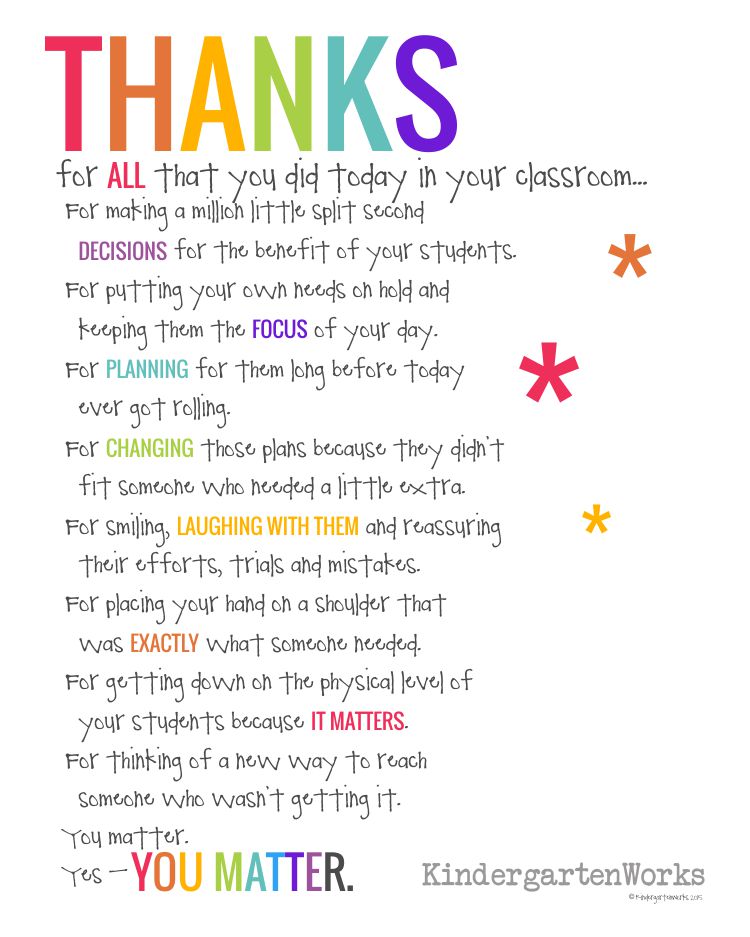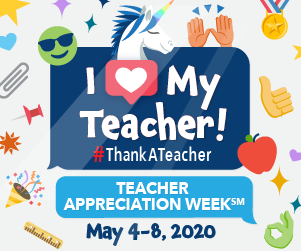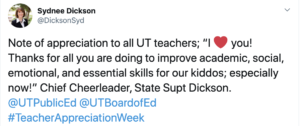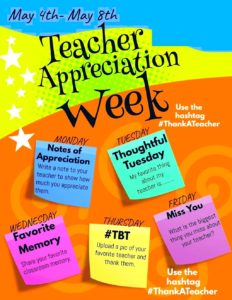Earn Credit by Reading Corwin Books

Wanting to earn credit? Corwin has a deal where you can earn credit for reading their books. To learn more, check out their link!
Author: awood
Thanks Teachers!

Thanks to Leslie at Kindergartenworks.com for the teacher appreciation poem free download!
Thank You!
Our teachers are amazing! We will never forget what you’ve done during this interesting time in history. Thanks for going the EXTRA mile with remote teaching.

National Teacher Appreciation Day!
Yesterday was National Teacher Appreciation Day! Thank you teachers!

Do you know the origins of National Teacher Day? It is believed it began in 1944. An Arkansas teacher, Mattye Whytte Woodridge was writing to political and educational leaders asking for a national day for teachers to be honored. One of her letters made it to the desk of Eleanor Roosevelt. In 1953, Mrs. Roosevelt worked with groups like National Educators Association (NEA) to convince congress that there should be a national teacher day.
It took decades for congress to declare the first National Teacher Day on March 1, 1980, and it was only for that year. But a movement had started to make it an annual thing with NEA on the first Tuesday in March. In 1985, the NEA Representative Assembly voted that the first Tuesday in March would be National Teacher Day. Then, the National Parent Teacher Association decided to take this a step further and decided the first full week of May would be Teacher Appreciation Week.
To learn more about Mattye Whytte Woodridge and the history of National Teacher Day, check out this blog post:
It’s National Teacher Appreciation Week!
Take time on social media to thank teachers or colleagues you know with this hashtag #ThankATeacher
There are a few different social media campaigns you can participate in.
| This is NEA's Teacher Appreciation Week Prompts. Visit their website for graphics to post with it!
http://www.nea.org/grants/teacherday.html
|
State Superintendent Syd Dickson shared a Teacher Appreciation campaign as well on Twitter!
|
Thanks for all you do!
May the Fourth Be With You – Teacher Appreciation!
Building Your Resilience
Building Your Resilience
From: American Psychological Association
Like building a muscle, increasing your resilience takes time and intentionality. Focusing on four core components — building connections, fostering wellness, finding purpose and embracing healthy thinking — can empower you to withstand and learn from difficult experiences.
The important thing is to remember you’re not alone on the journey. While you may not be able to control all of your circumstances, you can grow by focusing on the aspects of life’s challenges that you can manage with the support of loved ones and trusted professionals.
https://www.apa.org/topics/resilience

You Are Doing Your Best
"Education breeds confidence. Confidence breeds hope. Hope breeds peace." ~Confucius
May the effort you spend on behalf of your students while you are at home bring you peace knowing you have done your best. Thank you for your amazing work!

Turning Our Home Into Our Workspace
 In a video message from Marie Kondo with Time, she offers suggestions on creating an at home work space. She recommends:
In a video message from Marie Kondo with Time, she offers suggestions on creating an at home work space. She recommends:
- Be aware of all family member’s schedules so you can compliment each other and organize priorities
- Thinking about how we spend our time
- Use mindset or meditation to shift your mind into work mode
- Find a sense of calm by focusing on what you accomplished at the end of the day
You can watch Marie's video by clicking here.
Teaching Students to Hope for the Best
Teaching Students to Hope for the Best
By Mary Ellen Flannery, quoting Rick Miller

"Teachers can control the hope. As teachers we can control whether we believe in them, whether we have their back, and whether we can help them plan for the future.
Kids do better when they’re surrounded by adults who believe in them; kids do better when they have meaningful and sustainable relationships with adults; and kids do better when they can articulate their futures. That is hopefulness.
Just like reading and math, hope is something that students need to practice—and adults need to teach. The more hope students have, the happier and healthier they are, the more they persist in academic lessons, and the likelier they are to graduate.”
Keep up the great work teachers! You foster hope!



